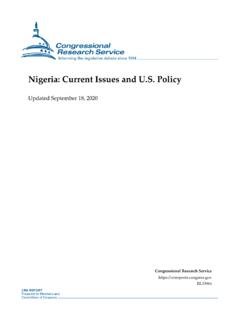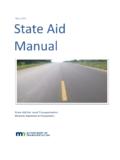Transcription of E. GENERAL SURVEY OF I.R.C. 501(c)(12) COOPERATIVES AND ...
1 E. GENERAL SURVEY OF 501(c)(12) COOPERATIVES AND EXAMINATION OF CURRENT ISSUES by Michael Seto and Cheryl Chasin 1. Introduction This article discusses GENERAL cooperative principles and rules governing 501(c)(12) COOPERATIVES , the history of 501(c)(12) and other requirements that affect operations of 501(c)(12) COOPERATIVES , and current issues. 2. 501(c)(12) 501(c)(12) provides federal income tax exemption for benevolent life insurance associations of a purely local character , mutual ditch or irrigation companies, mutual or cooperative telephone companies, electric companies, or like organizations.
2 The Service has never distinguished the terms mutual or cooperative for purposes of 501(c)(12). This article will use the term cooperative. The purpose of an 501(c)(12) organization is to provide certain services to its members at the lowest possible cost. To qualify for and maintain exemption under 501(c)(12), a cooperative must receive 85 percent or more of its income each year from members. The income must be collected solely to meet the cooperative s losses and expenses. 3. GENERAL History of COOPERATIVES The cooperative form of organization originated in England in the early 1800 s to improve the economic lot of workers and farmers, two groups that suffered during the industrial revolution.
3 Workers, with little bargaining power, suffered low wages. Farmers operated in an especially precarious economic environment, paying retail prices for their raw materials, but selling their output wholesale in markets that fluctuated widely and unpredictably. To gain economic power, workers and farmers organized and pooled resources to form sufficient capital to control the means of production, obtain supplies and services, or market their goods or services. The cooperative became very popular, and it spread to and throughout the United States. Congress recognized the contributions and importance of COOPERATIVES even before ratification of the Sixteenth Amendment to the Constitution authorized the income tax.
4 Congress provided exemption from federal excise taxes to cooperative companies, not-for profit mutual benefit associations, and agricultural, horticultural, and domestic GENERAL SURVEY of 501(c)(12) COOPERATIVES and Examination of Current Issues building and loan associations. See, The War Revenue Act of 1898, Pub. L. No. 55-133, 30 Stat. 448 (1898) and Pub. L. No. 61-5 38, 36 Stat. 11, 115 (1909). 4. Legislative History of 501(c)(12) After ratification of the Sixteenth Amendment, exemption from federal income taxes for mutual or cooperative insurance companies, ditch or irrigation companies, telephone companies and like organizations was first enacted in the Revenue Act of 1916, Pub.
5 L. No. 64-271, ch. 462 11(a)(10), 39 Stat. 756, 767 (1916) ( 1916 Statute ), reenacted in successive revenue acts, and in the 1939, 1954 and 1986 Internal Revenue Codes. Electric COOPERATIVES , which were not specifically listed in the 1916 Statute, but were recognized by the Service as like organizations in 1671, II-1, 158 (1923) and Rev. Rul. 67-265, 1967-2 205, were added to 501(c)(12)(C) in 1980. Before 1924, the statute limited COOPERATIVES income to assessments, dues, and fees from members. The Revenue Act of 1924, ch. 234, 231(10), 43 Stat. 283 (1924), reduced the member-income requirement to 85 percent, allowing COOPERATIVES to earn up to 15 percent of their income from nonmember sources.
6 Congress intended to allow COOPERATIVES to have other sources of income, such as interest on bank accounts, to pay for capital improvements, expansion, or to purchase real estate. See 65 Cong. Rec. 7128 7129 (1924). The 85 percent member-income test was intended to insure COOPERATIVES continued serving members rather than placing their member-source income in investments, such as bonds or stocks, and becoming investment companies. See Cong. Rec. 3433 (1926). 5. Other COOPERATIVES Congress also provided special tax rules for two kinds of COOPERATIVES in addition to those described in 501(c)(12).
7 These are Subchapter T COOPERATIVES and farmers COOPERATIVES . Subchapter T COOPERATIVES are governed by sections 1381-1388 (these provisions are in Subchapter T of the Code). These COOPERATIVES may conduct any kind of business. Examples are housing, insurance, etc. Their members or patrons can include individuals or organizations. Subchapter T COOPERATIVES are not exempt from federal income tax. Rather, their earnings are taxed at either the cooperative level or member-patron level, or both. A subchapter T cooperative must usually pay tax on patronage source earnings it retains.
8 It can deduct patronage-source earnings it distributes to its member-patrons from its gross income. Only patronage-source earnings are eligible for deduction by the cooperative, and they are taxable income to member-patrons who receive them. A Subchapter T 176 GENERAL SURVEY of 501(c)(12) COOPERATIVES and Examination of Current Issues cooperative is subject to tax on its net non-patronage source earnings, and patrons are subject to tax on distributions of non-patronage income. 521 and in Subchapter T provisions govern farmers COOPERATIVES . Farmers COOPERATIVES purchase supplies needed for farming on behalf of member-patrons and in turn market member-patrons farm products.
9 Member-patrons must be engaged in farming, which includes raising livestock, poultry, and fish, growing fruit, maintaining nurseries, etc. Like a Subchapter T cooperative, a farmers cooperative s earnings are taxed at either the cooperative level or the patron level. Unlike Subchapter T COOPERATIVES , farmers COOPERATIVES are exempt from federal income tax because they can reduce taxable earnings to zero by taking certain deductions from gross income under 521 and Subchapter T. For example, a farmer s cooperative can deduct non-patronage source net income and dividends it pays to shareholders.
10 A major difference between 501(c)(12) COOPERATIVES and farmers and Subchapter T COOPERATIVES is that an 501(c)(12) cooperative s earnings are not subject to federal income tax. Thus, they do not need to take deductions if they continue to meet the requirements for exemption under 501(c)(12). 6. Requirements for Exemption under 501(c)(12) An organization must satisfy three requirements to qualify under 501(c)(12). First, it must be organized and operated as a cooperative. Second, it must conduct activities described in 501(c)(12) and the regulations. Third, it must derive 85 percent or more of its income from members.














